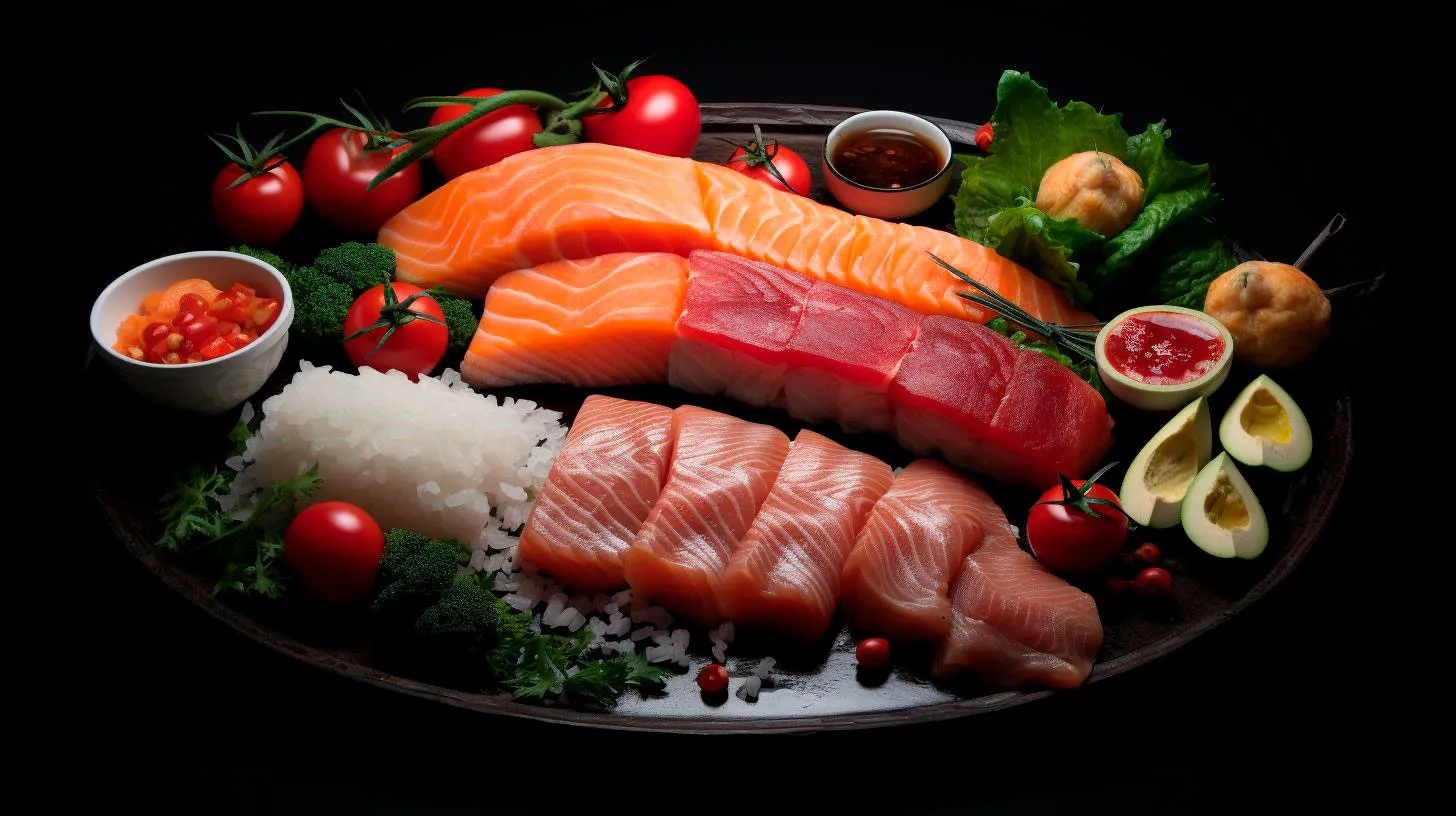Sushi Showdown: Comparing Japanese and American Styles
So, fasten your seatbelts as we embark on a tantalizing journey of flavors.
The Craftsmanship Behind Japanese Sushi
Japanese sushi is a culinary art form that dates back centuries. It emphasizes the natural flavors of the ingredients, meticulously prepared with precision and attention to detail. Traditional sushi in Japan is often served as bite-sized pieces of raw or marinated fish, placed on a small mound of vinegared rice. Here are some highlights of the Japanese sushi style:
- Quality Ingredients: Japanese sushi chefs focus on sourcing the freshest, highest quality ingredients, such as raw fish, seafood, and seasonal vegetables.
- Presentation: Japanese sushi presentations are visually stunning, with beautiful colors and intricate arrangements that are almost too pretty to eat.
- Flavor Balance: Each piece of sushi is meticulously crafted to achieve a delicate balance of flavors, often accompanied by wasabi, soy sauce, or pickled ginger.
Japanese sushi culture embraces simplicity, allowing the raw ingredients to shine. It is believed that the true essence of the fish can only be appreciated when it is not overpowered by excessive seasoning or sauce.
The Fusion and Creativity of American Sushi
American sushi, on the other hand, is a creative blend of traditional Japanese techniques and local tastes. It incorporates various cultural influences and innovations, offering a wider range of flavors and variations. Here are some distinctive features of American sushi:
- Ingredients and Fillings: American sushi often features a variety of fillings, including cooked fish, tempura, cream cheese, and even unconventional options like avocado or mango.
- Specialty Rolls: American sushi is known for its elaborate specialty rolls, where creativity and experimentation run wild. These rolls combine unique ingredients, textures, and flavors to create a feast for the senses.
- Sauces and Spicy Tuna: American sushi is famous for the inclusion of rich sauces, such as spicy mayo and eel sauce, often drizzled over rolls to enhance the overall taste.
American sushi embraces innovation and playfulness, resulting in a wide range of non-traditional options that cater to diverse palates.
Understanding the Cultural Nuances
Both Japanese and American sushi styles have their cultural significance and are influenced by societal norms. It is essential to understand and respect these differences:
- Japanese Cultural Significance: In Japan, sushi represents an intrinsic part of the culture, deeply rooted in tradition and precision. It is often enjoyed in quiet, intimate settings, showcasing the Zen-like connection between the chef, ingredients, and diner.
- American Societal Context: In America, sushi has gone through a cultural evolution, adapting to local tastes and preferences. It has become a mainstream food choice, offering a sense of adventure and variety.
Whether you prefer the authentic minimalism of Japanese sushi or the creative flair of American sushi, both styles have their own unique appeal.
Key Takeaways
As we wrap up our comparison between Japanese and American sushi styles, here are some key takeaways:
- Japanese sushi focuses on quality ingredients and simplicity, highlighting natural flavors.
- American sushi offers a fusion of flavors and creative experimentation, appealing to a broader range of palates.
- Japanese sushi emphasizes presentation, while American sushi showcases elaborate specialty rolls.
- Both styles have cultural significance and reflect the respective societies they originate from.
So, the next time you indulge in sushi, take a moment to appreciate the craftsmanship and cultural heritage behind each delectable bite. Whether you find yourself drawn to the subtlety of Japanese sushi or the boldness of American sushi, one thing is for sure – sushi is a global culinary treasure that brings joy and satisfaction to countless food enthusiasts worldwide.
Deconstructing Sushi: Unveiling the Key Ingredients
In this article, we’ll take a deeper dive into the world of sushi, deconstructing its key ingredients and unraveling the secrets behind its delightful flavors.
1. Sushi Rice
Central to the creation of any sushi dish is the sushi rice. Unlike regular rice, sushi rice is short-grained and sticky, thanks to its unique composition. This variety of rice is cooked with vinegar, sugar, and salt, imparting a delicate balance of flavors that perfectly complements the other ingredients. The stickiness of the rice is crucial as it helps to hold the sushi roll together.
Key Takeaway:
- Sushi rice is short-grained and sticky due to the addition of vinegar, sugar, and salt.
- The stickiness of the rice is essential for holding the sushi roll together.
2. Fish and Seafood
Arguably the most iconic ingredient in sushi, the fish and seafood selection plays a vital role in determining the taste and quality of each sushi piece. Popular choices include tuna, salmon, yellowtail, shrimp, and eel. Sushi-grade fish must meet specific standards to ensure freshness and safety. These delectable ocean treasures are often expertly sliced and carefully arranged on top of sushi rice to create nigiri or served inside the roll for maki sushi.
Key Takeaway:
- A wide variety of fish and seafood can be used in sushi, with tuna, salmon, and shrimp being popular choices.
- Sushi-grade fish must meet stringent standards to ensure freshness and safety.
3. Nori Seaweed
Nori seaweed is a vital component that holds the sushi roll together and imparts a unique texture and flavor. Harvested from the ocean, it is dried and processed into thin, edible seaweed sheets. The nori sheet provides a satisfying crispness to contrast with the tender fillings inside the sushi roll.
Key Takeaway:
- Nori seaweed is harvested from the ocean and processed into thin sheets.
- It adds a crisp texture and a distinctive flavor to sushi rolls.
4. Vegetables and Fillings
Vegetables and fillings bring color, crunch, and additional flavors to sushi rolls, making them even more exciting and vibrant. Cucumber, avocado, carrots, and daikon radish are commonly used vegetables in sushi. These fresh ingredients provide a pop of color and a crisp texture to balance the softer elements. Additionally, fillings like tempura, cream cheese, and spicy mayo offer a fusion of flavors and textures that take sushi to new heights.
Key Takeaway:
- Vegetables such as cucumber, avocado, and carrots add color and crunch to sushi rolls.
- Fillings like tempura, cream cheese, and spicy mayo offer diverse flavors and textures.
5. Condiments and Dipping Sauces
No sushi experience is complete without the accompaniment of various condiments and dipping sauces. Soy sauce, wasabi, and pickled ginger are staples that enhance the flavors of sushi. Soy sauce provides a salty umami taste, while wasabi adds a fiery kick. Pickled ginger serves as a palate cleanser, refreshing the taste buds between different sushi rolls.
Key Takeaway:
- Soy sauce, wasabi, and pickled ginger enhance the flavors of sushi.
- Soy sauce provides a salty umami taste, while wasabi adds spiciness.
- Pickled ginger serves as a palate cleanser, refreshing the taste buds.
Conclusion
Sushi represents the perfect harmony between delicate flavors, textures, and presentation. By deconstructing sushi and understanding its key ingredients, we can appreciate the meticulousness and artistry that goes into creating this revered culinary masterpiece. From the sticky sushi rice to the fresh fish and seafood, the crisp nori seaweed, vibrant vegetables, and the tantalizing condiments, each element plays a crucial role in shaping the sushi experience.
The next time you indulge in a sushi feast, take a moment to savor each bite and appreciate the subtle nuances delivered by these key ingredients. Whether you’re a sushi connoisseur or a curious food lover, understanding the building blocks of sushi will undoubtedly deepen your appreciation for this timeless delicacy.
From Tokyo to LA: A Taste of Japanese Sushi versus American Sushi
One of the most notable transformations is American sushi.
In this article, we’ll delve into the key differences between Japanese sushi and its American counterpart, exploring the cultural nuances and flavor profiles that define each. So, grab some chopsticks and join us on this sushi-filled journey!
The Origins of Sushi
Before we dive into the comparison, it’s important to understand the origins of sushi. Dating back centuries, sushi was initially developed in Southeast Asia as a way to preserve fish using fermented rice. Over time, this preservation method evolved, and sushi reached Japan, where it became the beloved cuisine we know today.
Japanese Sushi: Tradition Meets Perfection
Japanese sushi embodies the essence of precision, technique, and simplicity. It is often characterized by the use of minimal ingredients, focusing on the natural flavors of the fish themselves. The following features define Japanese sushi:
- Quality and Freshness: Japanese sushi emphasizes the use of the freshest fish available, with a focus on seasonal and local ingredients.
- Nigiri: This classic form of sushi consists of a small mound of vinegary rice topped with a slice of raw or cooked fish.
- Sashimi: Unlike nigiri, sashimi refers to thin slices of raw fish served without rice.
- Traditional Condiments: Japanese sushi is accompanied by soy sauce, wasabi, and pickled ginger, which enhance the flavors without overpowering the delicate taste of the fish.
Japanese sushi chefs spend years perfecting their craft, mastering the art of knife skills and the balance of flavors. The meticulous attention to detail and dedication to quality make dining on Japanese sushi an unforgettable experience.
American Sushi: Fusion and Creativity
American sushi, also known as “westernized sushi,” has taken a more adventurous approach, blending traditional Japanese techniques with local ingredients and flavors. American sushi has its own unique characteristics:
- Role of Creativity: American sushi chefs are known for their creativity, constantly introducing new ingredients and combinations to cater to the evolving palates of their customers.
- Specialty Rolls: American sushi is renowned for its elaborate specialty rolls that often include a variety of ingredients such as avocado, cream cheese, and unique sauces.
- Fusion Flavors: American sushi frequently incorporates diverse cuisines, such as Mexican, Korean, and Hawaiian, resulting in unique flavor profiles.
- Precise Presentation: American sushi showcases artistic plating, with colorful garnishes and intricate arrangements that appeal to both the eyes and taste buds.
American sushi embraces innovation and diversity, offering a broader range of options to satisfy individual preferences and culinary fusions.
The Key Takeaways
Now that we’ve explored the main differences, let’s summarize the key takeaways:
- Japanese sushi emphasizes simplicity, highlighting the natural flavors of the fish and quality ingredients.
- American sushi incorporates fusion flavors and creativity, resulting in unique and often elaborate rolls.
- Both styles offer a delightful culinary experience, providing different approaches to sushi appreciation.
- Whether you prefer the traditional elegance of Japanese sushi or the bold experimentation of American sushi, there’s a style to suit every sushi lover.
While Japanese sushi remains deeply rooted in tradition, American sushi has evolved into its own distinct art form, reflecting the cultural diversity and creativity of its adoptive country.
So, the next time you find yourself seeking sushi, ponder upon the gastronomic journey you’d like to embark on. Will it be the simplicity and precision of Japanese sushi or the innovative and adventurous flavors of American sushi? Whichever path you choose, one thing is for sure: sushi has truly become a global sensation, connecting cultures and palates across continents.
The Art of Sushi: Revealing Traditional Japanese Ingredients
In this article, we will dive into the world of sushi and explore the fascinating traditional ingredients that make it an irresistible delight.
The Foundation: Vinegared Rice
At the heart of every sushi roll lies the key ingredient that holds everything together – vinegared rice. Known as “shari” in Japanese, this short-grain rice is cooked with a special vinegar-based mixture called “su.” The combination of rice and su creates a distinct tangy flavor that complements the other components of sushi. With the right balance of moisture and stickiness, shari provides the perfect foundation for sushi.
The Stars of the Show: Fish and Seafood
When it comes to sushi, fresh and high-quality fish or seafood is crucial. Such ingredients are the stars of the show, bringing a burst of flavor and texture to each bite. Here are some notable traditional fish and seafood used in sushi:
- Maguro (Tuna): Maguro is one of the most popular and beloved fish used in sushi. It boasts a rich, melt-in-your-mouth texture and a deep red color that adds vibrancy to any sushi roll.
- Sake (Salmon): Sake, with its buttery, fatty texture, is another favorite among sushi lovers. Its distinct orange-pink hue adds visual appeal, while its delicate flavor enhances the overall sushi experience.
- Ebi (Shrimp): Ebi, or shrimp, provides a delightful contrast with its crisp texture and subtle sweetness. Often served as nigiri sushi, it offers a delightful snap that complements the softness of the rice.
- Hamachi (Yellowtail): Hamachi, a type of yellowtail fish, delights sushi enthusiasts with its rich, buttery taste and smooth texture. Its mild flavor pairs well with other ingredients, making it a popular choice.
Embracing Umami: Traditional Ingredients
In addition to fish and seafood, sushi incorporates a range of traditional Japanese ingredients that elevate the flavors and add depth to this iconic dish. Let’s explore some of the most notable ones:
- Nori (Seaweed): Nori, a type of edible seaweed, is the thin, dark green sheet that wraps around sushi rolls. It not only adds a pleasant briny taste but also provides a crucial structural element to hold the ingredients together.
- Wasabi: This vibrant green paste is made from the grated root of the wasabi plant. A small amount of wasabi adds a spicy kick to sushi, enhancing the overall flavor profile.
- Gari (Pickled Ginger): Gari, pickled ginger, cleanses the palate between sushi bites. It offers a refreshing and tangy taste that complements the fish by providing balance.
- Soy Sauce: Soy sauce, or shoyu, is a staple condiment in Japanese cuisine. Its salty and savory flavor enhances the taste of sushi when used in moderation.
- Sesame Seeds: Toasted sesame seeds are often sprinkled on top of sushi rolls to add a nutty flavor and provide a pleasing visual contrast.
Key Takeaways
Sushi is truly an art form, perfected over centuries. Understanding the traditional Japanese ingredients that go into this delicacy helps us appreciate the craftsmanship and flavor in every piece. Here are some key takeaways to remember:
- High-quality and fresh fish or seafood are essential for exceptional sushi.
- Vinegared rice forms the foundation and provides a perfect balance to the other ingredients.
- The traditional ingredients like nori, wasabi, gari, soy sauce, and sesame seeds contribute to the unique flavor profile of sushi.
Next time you indulge in sushi, take a moment to savor the blend of flavors, textures, and colors that make it a true work of art. Whether it’s the rich, marbled tuna or the delicate sweetness of shrimp, each ingredient adds its own special touch to this iconic Japanese dish.


